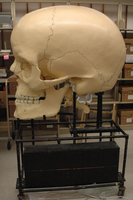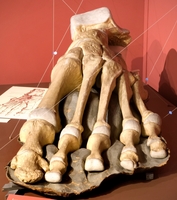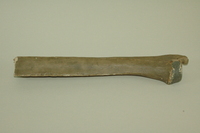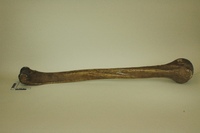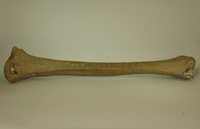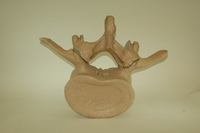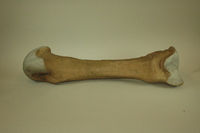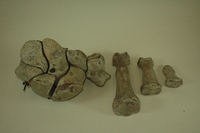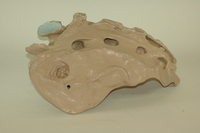Dwight-Emerton Collection, 1890-1895. WAM 21246-21247, 21532, 21534-21539, 21551-21556.
Dublin Core
Title
Dwight-Emerton Collection, 1890-1895. WAM 21246-21247, 21532, 21534-21539, 21551-21556.
Alternative Title
Thomas Dwight and J. H. Emerton Teaching Model Collection
Subject
Medical Education
Dwight, Thomas, 1843-1911
Emerton, James Henry, 1847-1930
Description
Thomas Dwight was born to Thomas Dwight and Mary Collins Warren in 1843. Dwight’s father converted to Catholicism late in life, and Dwight and his mother were baptized Catholic in 1855. Dwight spent several years in France as a young child, and upon returning to the United States, he attended Dr. Dixwall’s School in Boylston Place. He did not complete his degree from Harvard College, but he joined Harvard Medical School and graduated with the class of 1867. He was granted an A.B. from Harvard in 1872. After graduating, he served as house officer at Massachusetts General Hospital, Boston, Massachusetts. He spent two years in Europe: though his surgical experiences in Vienna and Berlin were not particularly fruitful, he benefited from his study of frozen anatomy in Munich. When he returned to the United States, he was Surgeon to Out-Patients at the Boston City Hospital, Boston, Massachusetts (1877-1880) and Visiting Surgeon to the Carney Hospital, South Boston, Massachusetts. From 1872 to 1876, Dwight taught at both Bowdoin College, Brunswick, Maine, and at Harvard Medical School. At Bowdoin, he was Lecturer in Anatomy and then Professor of Anatomy. He used frozen sections in his teaching. When he was asked to identify the sex and stature of a murder victim, he became interested in the medico-legal possibilities of anatomy. At Harvard, he started as Instructor in Comparative Anatomy (1872), and then became Instructor in Histology (1874), Instructor in Topographical Anatomy (1880), and Parkman Professor of Anatomy (1883). Dwight was an expert dissector and used x-rays to inform his work and his teaching. He was interested in the normal variations in the human body. His significant publications include Frozen Sections of a Child (1881) and Variations of the Bones of the Hands and Feet (1907). He also contributed to Textbook of Anatomy, edited by Dr. Piersol, and his chapters on bones and joints were the best writing on the topic at the time. His paper on “Intracranial Circulation” won the Boylston Medical Prize. He was a founder and editor of the Anatomical Record. He also edited the Boston Medical and Surgical Journal from 1873 to 1878. In 1869, he was named a doctor of laws by Georgetown University, in Washington, D.C.. He made significant contributions to the Warren Museum, particularly the osteological preparations, but also corrosions, frozen sections, and papier-mâché models. As a faithful Catholic, Dwight was involved in the Saint Vincent de Paul Society and other Catholic organizations. As a trustee of the Boston Public Library, he fought for the inclusion of Catholic materials. Dwight father’s family, of Dedham, Massachusetts, was significant in New England history, and his mother was the daughter of John Collins Warren, part of a family of doctors who were significant in the development of Harvard Medical School. Dwight died of cancer on September 8, 1911, at his summer home in Nahant.
James Henry Emerton was born in 1847 in Salem, Massachusetts. He began to study natural history at the Essex Institute at the age of fifteen. He became an assistant at the museum of the Boston society of natural history in 1873. In 1875 he moved to Europe, where he studied at the University of Leipzig and the University of Jena. Emerton began work at the Salem museum in 1879, and became an assistant at the Yale museum in 1880. Emerton was particularly interested in spiders and delivered many lectures on this topic. Emerton authored a number of publications, including “Notes and Additions to a Second Edition of Hentz's Spiders of the United States” (1875), “Structures and Habits of Spiders” (1877), and “Life on the Seashore” (1880). Emerton was also an artist. He created a series of anatomical sculptures for Parkman Professor Thomas Dwight in 1890. He also illustrated many scientific publications, including A.S. Packard's "Guide to the Study of Insects" (1869), Addison Emery Verrill's papers in "Reports of the United States Fish Commission" (1884), and George Minot's "Embryology" (1892). Emerton died in 1930.
This collection contains a series of 20 large papier-mache anatomical models. Between 1890 and 1895, sculptor James Henry Emerton, under the direction of Dr. Thomas Dwight, Parkman Professor of Anatomy at Harvard Medical School, created this series of models for use as teaching aids. The models continued to be used in classrooms at Harvard Medical School throughout the twentieth century.
James Henry Emerton was born in 1847 in Salem, Massachusetts. He began to study natural history at the Essex Institute at the age of fifteen. He became an assistant at the museum of the Boston society of natural history in 1873. In 1875 he moved to Europe, where he studied at the University of Leipzig and the University of Jena. Emerton began work at the Salem museum in 1879, and became an assistant at the Yale museum in 1880. Emerton was particularly interested in spiders and delivered many lectures on this topic. Emerton authored a number of publications, including “Notes and Additions to a Second Edition of Hentz's Spiders of the United States” (1875), “Structures and Habits of Spiders” (1877), and “Life on the Seashore” (1880). Emerton was also an artist. He created a series of anatomical sculptures for Parkman Professor Thomas Dwight in 1890. He also illustrated many scientific publications, including A.S. Packard's "Guide to the Study of Insects" (1869), Addison Emery Verrill's papers in "Reports of the United States Fish Commission" (1884), and George Minot's "Embryology" (1892). Emerton died in 1930.
This collection contains a series of 20 large papier-mache anatomical models. Between 1890 and 1895, sculptor James Henry Emerton, under the direction of Dr. Thomas Dwight, Parkman Professor of Anatomy at Harvard Medical School, created this series of models for use as teaching aids. The models continued to be used in classrooms at Harvard Medical School throughout the twentieth century.
Provenance
In November 2013, the Program for Medical Education at Harvard Medical School transferred several Dwight-Emerton models to the Warren Anatomical Museum.
Collection Items
View all 15 itemsCollection Tree
- Warren Anatomical Museum
- Dwight-Emerton Collection, 1890-1895. WAM 21246-21247, 21532, 21534-21539, 21551-21556.

